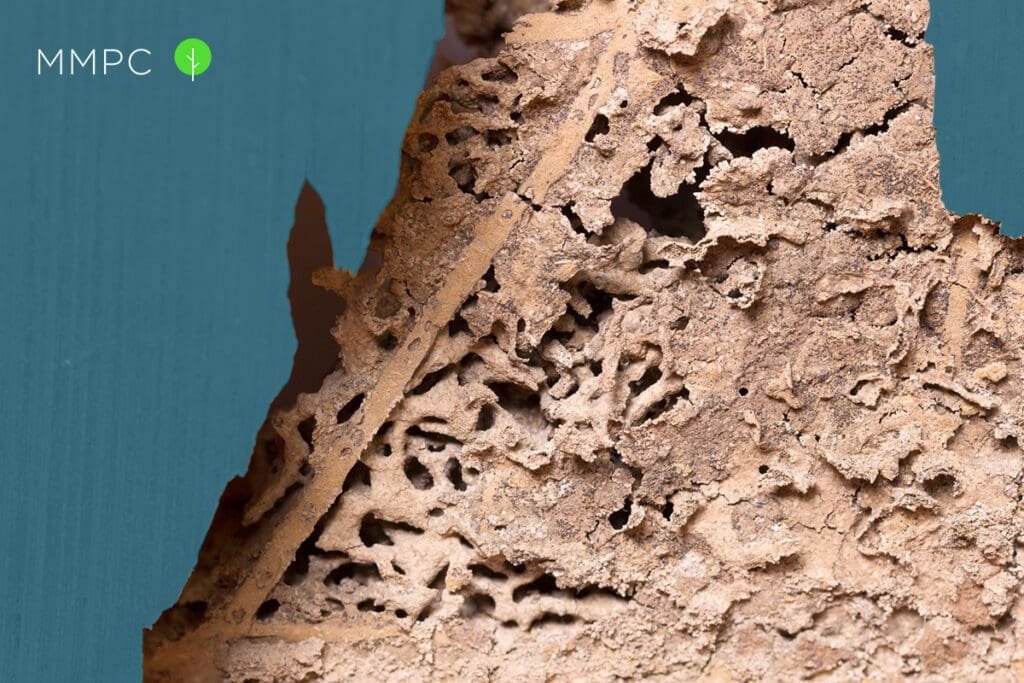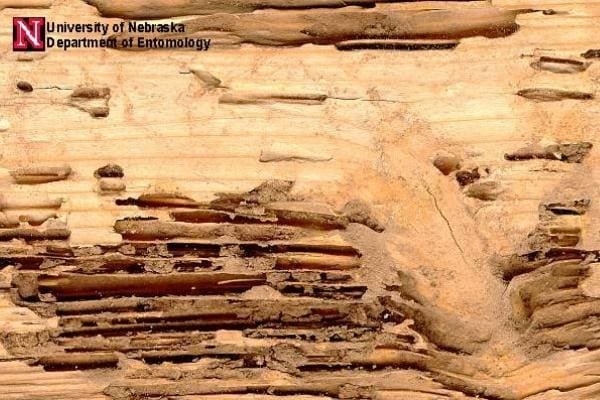
When termites aren’t discovered early on, they can cause major and long-lasting problems that are expensive to repair. However, signs of damage can sometimes be difficult to find and identify.
In this article, we’ll explain what termite damage looks like and how to differentiate it from other common issues.
What Does Termite Damage Look Like?
As termites chew through wood to form termite galleries and tunnels, the wood becomes hollow and weak. How they tunnel through the wood, and the resulting signs of damage, depends on the species of termite:
Subterranean Termite Damage
Since subterranean termites require a lot of moisture to survive, they build their nests in soil. In order to get inside, they create mud tubes, which are often found along the walls outside of your home.
These mud tubes are made of soil, frass, and wood chips, and they look like veins of dried dirt running along walls and cracks. Finding mud tubes is a telltale sign that you’re dealing with a subterranean termite infestation.
Subterranean termites typically only tunnel through the interior of wooden structures. The damage may not be visible until they’ve tunneled enough to compromise the structural integrity of the wooden structure they’re eating through.
Their tunnels and galleries of subterranean termites generally tend to follow the direction of wood grain. Inside, they are lined with muddy material.



Drywood Termite Damage
Unlike subterranean termites, drywood termites don’t need as much moisture to survive. They form colonies directly in hard, dry wood, and are more likely to infest wooden objects like furniture, picture frames, bed frames, and banisters.
Drywood termites also make tunnels and galleries where they feed and establish their nests. As they consume wood, they tend to leave behind a smooth, sculptured appearance.
One distinguishing feature of drywood termite damage is the presence of “kick-out holes” or exit holes. These are small, pin-sized holes that are visible to the naked eye, formed when termites tunnel through wood or drywall to the outside.
Drywood termite kick-out holes are often accompanied by small piles of frass, or termite droppings, which resemble tiny pellets or sawdust.



Where Does Termite Damage Typically Occur?
Termites have a continuous appetite for cellulose, which can be obtained from wood, drywall, cardboard, and other building materials.
Common places where termite damage can be found includes walls, support beams, door frames, attics, crawl spaces, and closets.
Other Problems Mistaken For Termite Damage
Some other potential issues that might be mistaken for termite damage include carpenter ants, water damage, and wood rot.
Carpenter Ants
Termites and carpenter ants are both considered wood-destroying insects. Carpenter ants don’t actually eat the wood like termites do, but they use wood for nesting and sheltering.
Similar to drywood termites, carpenter ants also drill small holes in wooden surfaces with tiny piles of sawdust outside. They also make smooth-looking tunnels as they make their way through wood. But unlike drywood termites, carpenter ants love moisture and are more likely to be found in areas with moist or damp wood.
One main difference between carpenter ant damage and termite damage is the absence of mud or soil in the hollowed-out tunnels.

Water Damage
Water damage occurs when a piece or section of wood is exposed to excess moisture or water. Common areas where water damage typically occurs is along roof lines, window and door frames, and on outdoor decks.
Wood that has water damage will appear darker and discolored. On walls and ceilings, water leaks can cause bubbling, peeling, or warped paint or wallpaper. Water damage on flooring can cause warping, sagging, or buckling.
The difference between termite damage and water damage is usually in the pattern and look of the damaged wood. Termite damage typically leaves the surface of wood with wavy grooves and a hollowed out appearance, while water damage causes the wood to darken and is usually accompanied by a musty or moldy odor.

Wood Rot
Wood rot is the result of a combination of water damage and fungal growth. Improper insulation, poor drainage, roof or siding damage, and structural cracks are a few of the common initial causes of wood rot.
Wet rot occurs when there is excess moisture in wood over long periods of time. The moisture is absorbed by the wood, causing it to soften and darken in color. Wet rot feels spongy and produces a musty, earthy smell.
Dry rot occurs when the fungi break down the components that give wood its strength, causing the wood to become brittle and weak. Dry rot can be identified by a gray-white ‘skin’ or covering on top of the darker wood.

Signs of Termite Damage
Since termite damage can be difficult to spot, it’s important to understand the early warning signs of termite damage. Keeping an eye out for these signs might help you identify a possible termite infestation before it gets worse.
- Stuck windows or doors
- Damage under paint or wallpaper
- Termite swarmers and discarded wings
- Mud tubes
- Termite droppings
About MMPC
If you suspect termite damage in your home, you can always reach out to a pest control professional. They will be able to determine whether or not you have a termite infestation and they can give you recommendations on what to do next.
MMPC is an eco-friendly pest control company based in New York City with over 25 years of experience combating termite infestations in the Tri-State Area.
